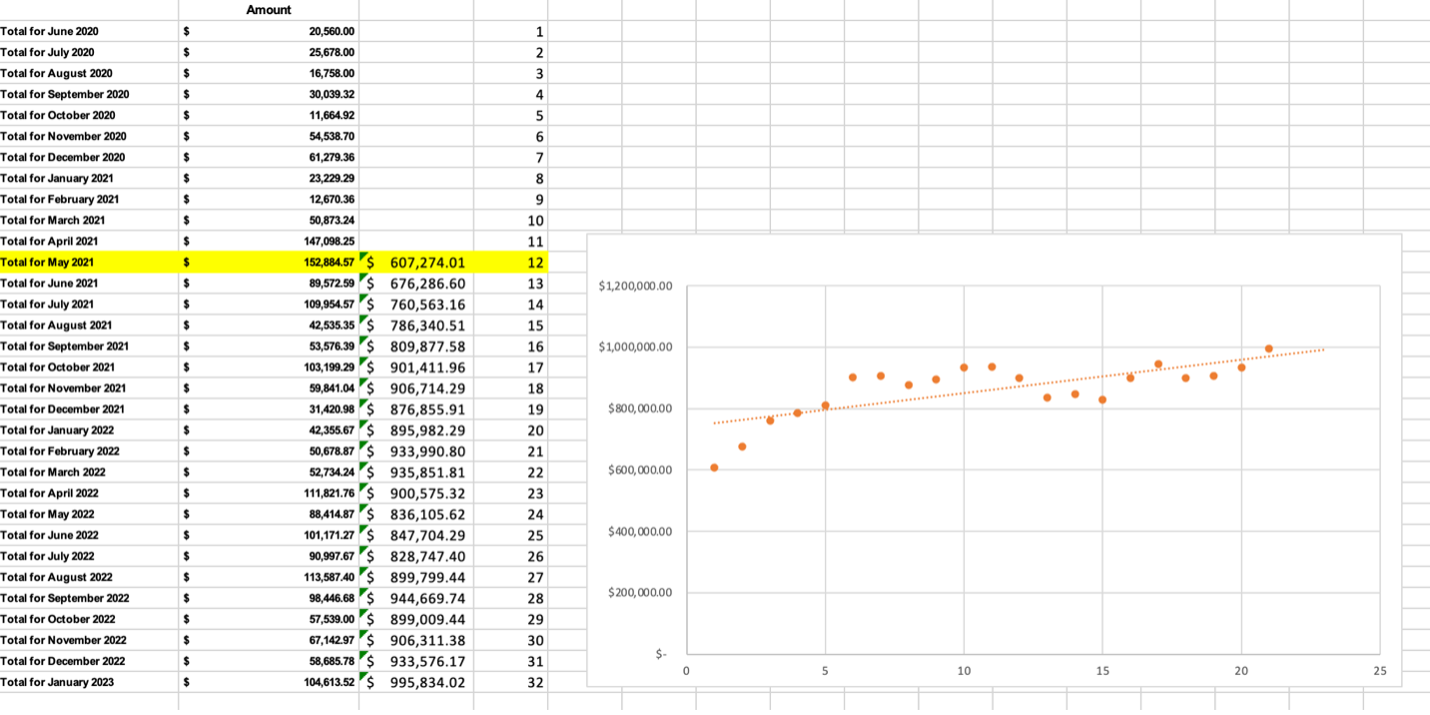Do You Need Help in Sales? Answer These 3 Questions First!
Apr 14, 2023
Do You Need Help in Sales? Answer These 3 Questions First!
The beautiful thing about sales is it will never be boring! Whether you are crushing it right now or struggling, it is my goal for this sales content to be useful to you and improve your life in some positive way. I applaud you for taking the time to learn something new – it is this curiosity and thirst for knowledge that has helped me learn new tools, insights, statistics, methods, and much more. In this article, I go over tools to help you answer 3 key questions important to know if you want to grow your sales – are you proactive or reactive? Is your sales process defined? Are you creating momentum?
Question #1 – Are You Proactive or Reactive?
Seeing the slowdown in sales before it happens is critical for a business to survive and thrive. Too often, businesses are reactionary when it comes to sales. They react with promotions and marketing campaigns that sometimes help but usually wreak of desperation and can hurt your brand's legacy. If you are proactive, you can be more strategic because you have more time to react. You can test, regroup, and relaunch.
Some of my favourite tools to help you be more proactive in sales are:
Rolling 12-Month Sales
- Measures total sales of your last 12 months and updates every month.
- Can be broken down by product, service, location, etc.
- Using a graph to see a trend line is critical.
- If you have months that are uncommon, like a huge project that only comes around once every few years, you can delete them in effort to ‘normalize the data.’
- If a trend line is added, can extend it and use to forecast future sales
See below example:
- For August 2022, it would show the total sales of September 2021 to August 2022
- For September 2022, it would show the total sales of October 2021 to September 2022
- And so on..

Sales Funnel
- To develop your sales funnel, it is required to understand the path your prospects take to become customers.
- Useful to understand the conversion rates for each level of the funnel to determine where the weak points are.
- Can be used to forecast how many leads/prospects (top of funnel) are required to win more deals and increase sales to meet quotas.
See below example:

CRM Software
- Critical for you to develop and track your sales funnel in real time to see if your funnel is ‘drying up’ or healthy and growing.
- Captures data to produce reports to help you determine trends and patterns.
- The type of software depends on a few things – the sales model, the role of the salesperson, the size of the business, the sales process, and the goals of the company (ROI from marketing, relationship management, automation, etc).
- My Top 3 are Microsoft Dynamics, Pipedrive, and Hubspot.
Question #2 – Is Your Sales Process Defined?
A defined sales process is crucial for many reasons but most importantly, it is your foundation to build upon. Without a defined sales process, it is near impossible to know what is working and what is not working other than using your intuition. If you want to scale, a defined sales process is a great way to start. Also, a sales process can be totally different for different customer types.
Example: A Canadian distribution company that sells its products into various industries, markets, and channels. The two biggest customer types are:
- Industry = Retail Trade, Market = Canada, Channel = Independent Retailers, B2B (Business to Business) and B2C (Business to Consumer)
- Industry = Accommodation and Food Services, Market = Canada, Channel = Full-Service Restaurants, DTC (Direct to Consumer)
Once you have your customer types defined by industry, market, and channel, it is recommended to dig deeper into each, to find the nuances for each type. It is very likely that your unique selling propositions and key success factors will be slightly different per type, possibly requiring a different sales process.
- What markets in Canada will you focus on?
- This is important because you do not want to spread yourself too thin and ‘water down’ your sales efforts. Also, what if you do not speak French? That would make it tough to compete in Quebec and some of the Maritimes. Pick a few high-level areas of focus to start – like major cities or regions.
- Once you have the high-level areas of focus, you want to understand the buyer personas – are your products expensive? If so, you will want to look at demographics and find the areas with higher incomes per household. This is either the same or different for each channel.
- Whom are you selling?
- This is where we see a big difference between types. For the Independent Retailers, we are selling to the decision-makers of the retail establishment, which could be the owner or procurement manager. For the Full-Service Restaurants, we are selling to the decision makers of the restaurant, which could be a chef or a restauranteur.
- For resellers, two key questions to have the answers to are ‘is my product being SOLD by this channel?’ and ‘is my product being PURCHASED from this channel?’. This is advanced, but important because ‘selling’ versus ‘purchasing’ is a much different sales process. This is also a key characteristic that separates independent retailers from mass merchandising retailers (Big Box). In this case, the Independent Retailers will be reselling the products to consumers and sometimes to other resellers such as landscape contractors and designers.
- Sold vs Purchased
- Sold – this is by far my favourite because it requires a salesperson to execute. Products and services in this category are almost always complex and consumers need to be educated and guided throughout the sales process. Also, it is likely that the product or service needs to be experienced via a demonstration or trial service. It is likely that any reseller for products and services in this category is specialized and not a mass merchant. Most luxury products fall into this category. In this category, training the sales staff of your reselling customer will be very important. If they are not confident in your product, they will shy away from selling it to their consumer network or will not be able to sell it because they cannot articulate the value effectively.
- Purchased – products and services in this category are mostly commodities that are not very complex and have a price point that is lower to mid-range and fits most budgets. Mass merchants such as Costco, Home Depot, Amazon, and Canadian Tire, and Rona fall into this category.
- For end users, two key questions to have the answers to are ‘what pain points does my product solve?’ and ‘what value does my product bring the end user?’. This is important because the difficulty in convincing your prospect will help determine the sales process – i.e: does it require a live demonstration?
- Sold vs Purchased
Looking at the breakdown above is top level and if you want to become more precise with your sales process, you will want to dig further – ‘peel more layers of the onion’. Getting into the head of your customer and if applicable, your customers' customer, is crucial to understanding the sales process.
Question #3 – Are you creating momentum?
Creating momentum in sales is very important to keep your sales teams confidence high. A big factor in creating and growing sales momentum is leadership. With an absent leader, it becomes nearly impossible for momentum to exist. The leader needs to be in-tune with what is going on with the team so they can implement changes and learnings at critical times to avoid lost momentum and thus, demotivation.
Some of my favourite tools to help you create and grow momentum in sales are:
The Four Disciplines of Execution
- If you haven’t read the book, I highly suggest it. It suggests a few things:
- Creating a Wildly Important Goal (WIG) as a team
- A weekly (at minimum) meeting of one hour a.k.a WIG Session
- Creating LEAD measures to move the suitable LAG measures
- Create and update a scoreboard weekly to track performance of Lead and Lag Measures
- Commit to 1-3 weekly activities dedicated to moving the scoreboard in a positive direction
Believe it or not, most sales teams do not have a Wildly Important Goal defined. This is like a ship without a rutter! A WIG is not a personal quota, it is much bigger than that. A properly defined WIG can help facilitate the entire team to be rowing in the same direction towards a common objective – the WIG. Once your WIG is defined, a weekly meeting dedicated to the WIG is key – it cannot be a meeting about anything else! This allows your team to communicate to one another but more importantly, hold each other accountable to the scoreboard and commitments. Usually, sales meetings are about the past because most sales teams are focused on LAG measures – sales $’s, units sold, etc. But those Lag Measures are mostly a result of certain activities – some activities are critical (LEAD Measures) and if tracked, can better predict the LAG Measures. By tracking Lead Measures, it helps keep the team focused and motivated because they know the Lag Measures will eventually follow. For long sales cycles, it could take months before a Lag Measure moves, and the absence of movement in the Lag Measures can demotivate the team.
Continuous Development
- Sales courses help keep your skills sharp in certain areas but can be costly.
- Sales books give you fresh sales ideas and perspectives for a minimal investment.
- Personal development books improve your overall health which is crucial for a stressful but rewarding career in sales.
- Sales coaches can teach you new sales specific skills and techniques and hold you accountable for implementing them to get results.
- Life coaches can guide you to become a healthier overall self which is crucial for high performance in the sales profession.
Networking
- Tradeshows are great for both sides and the good ones are almost always worth the time and investment.
- Conferences have different outcomes – some are great for industry knowledge and are usually massive to attract the masses whereas others can be smaller and more intimate leading to opportunities to build relationships and gain specific industry knowledge.
- Local Events are a great way to build your own and company brand at a local level and high-quality referrals and relationships.
- Golf Outings can be a secret weapon if you can hold your own and learn the proper balance of business versus personal during the round. TIP: Use the dinner and drinks after to talk some business – the course is best left as personal as possible.
For more actionable sales advice, sign up for our mailing list on our website. Thank you, and please share with your networks!
